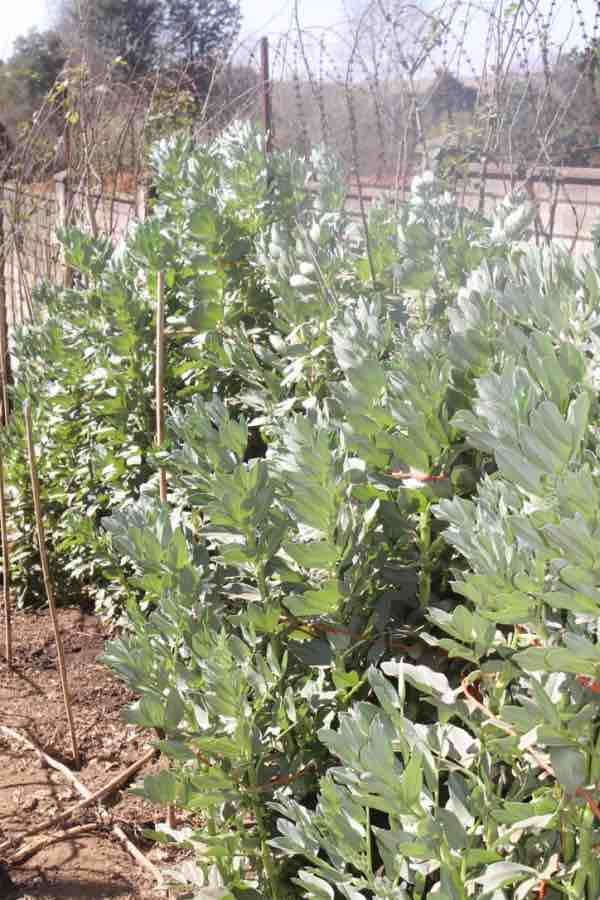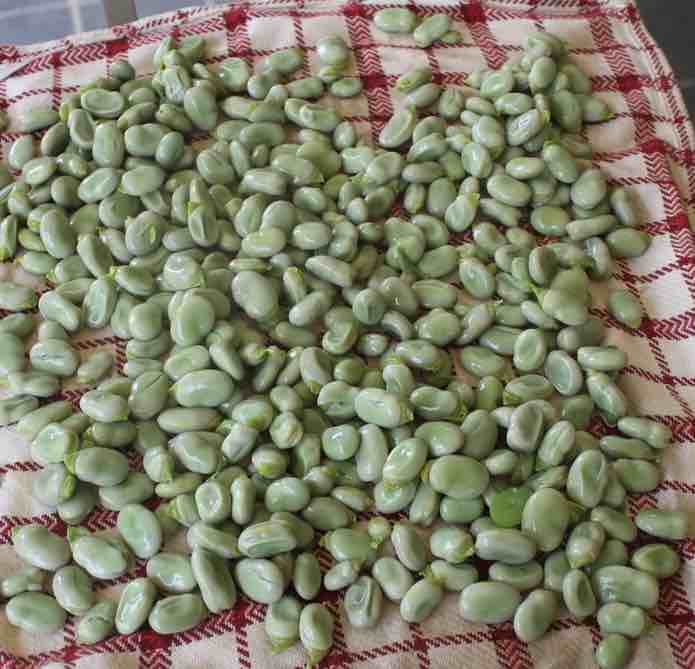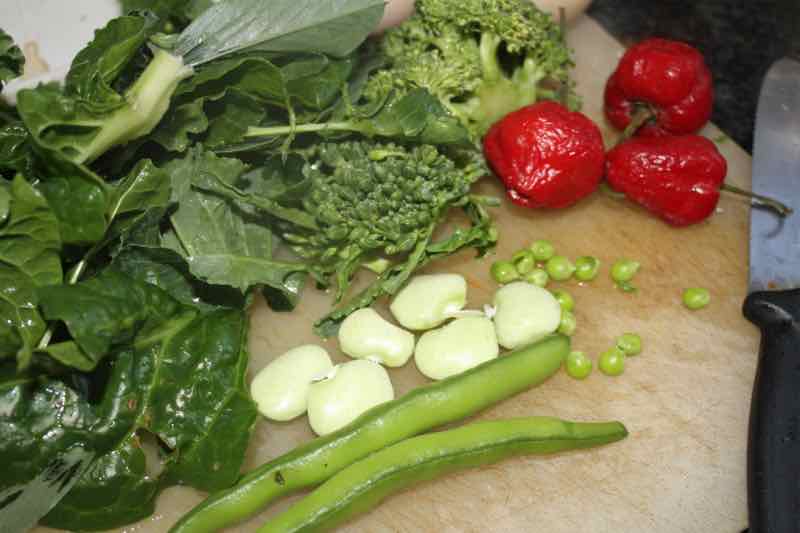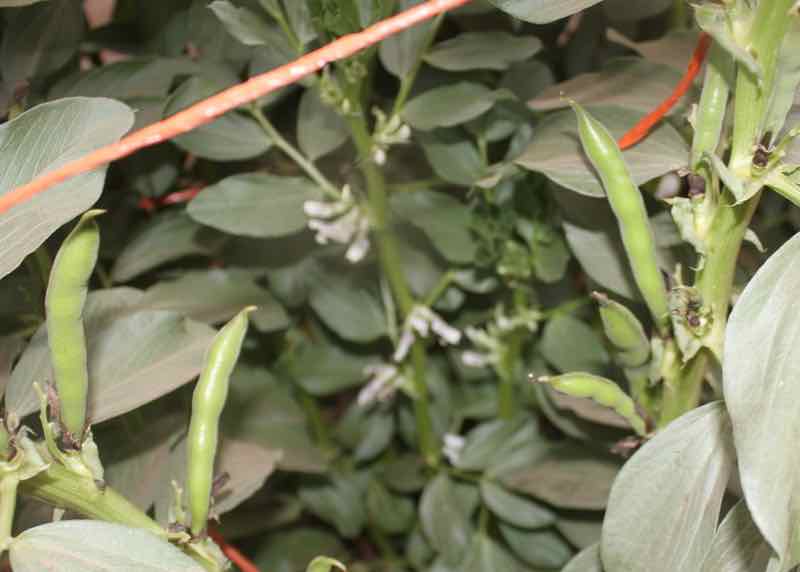- Bernard Preston homepage
- Our green garden
- Broad Bean Season
Broad bean season
The broad bean season means a reduction in the tremor in my right hand; favas as they are also known are the only common source of L-dopa.
I look forward to the broad bean season with unusual emotion. Firstly it means a lessening of the tremor that has troubled me for thirty years; and secondly it haunts me just how wrong one can be in life.
It’s well known that medical anecdotes have no scientific significance whatsoever. “I was infected by a virus, took vitamin C and was fine after three days.”
It is meaningless. One has to take hundreds of people with the bug, dividing them into three groups; give one an orange, another a capsule with the vitamin and the third a similar-looking pill with a placebo. How did they fare? Now you have a point of discussion.
 The broad bean season.
The broad bean season.But what if the anecdote is backed by strong science? Reporting in the Journal of Clinical and Diagnostic Research doctors have this to say.
“The consumption of broad beans can increase the levels of dopamine in the blood, with a marked improvement in the motor performance of patients with Parkinson's Disease; and no side effects.[1]”
My difficulties began some thirty years ago, with no known cause. A very thorough examination by a specialist concluded that it was not Parkinson’s Disease but an "essential tremor." It was and still is not noticeable at rest but rather when stretching out; and particularly holding a spoon. He said it might get worse but not necessarily so; and later on may turn into one of the neurodegenerative conditions.
Of course I was terrified but he was right and it has not worsened; and in fact more recently has been markedly better. Why is that?
How wrong one can be. As a teenager I was once forced to eat broad beans without complaint when we were visiting friends; they were old, starchy and perfectly horrid. I vowed they would never pass the threshold of my lips again, a promise I kept for fifty years.
Then when visiting family a mystery dish was amongst the various foods served. They were young, tender and simply delicious; broad beans, my host told me when I returned for seconds.
I decided to start growing them, not knowing how important they would be for my health. And so began a new adventure with this legume, also known as a fava bean. Discovering it is the second richest source of vegetable protein, about a quarter it fits with our determination to eat less red meat; and that it is the only significant origin of L-dopa.
That triggered memories of dopamine, the vitally important neurotransmitter that is deficient in those suffering from Parkinson’s Disease; and so began a literature search on the subject.
 It's easy for those wanting a year-round supply to blanche and freeze broad beans.
It's easy for those wanting a year-round supply to blanche and freeze broad beans.And so came the discovery that there are indeed many papers on broad beans, L-dopa and Parkinson’s Disease. I also noticed that during winter when they grow prolifically if you have enough water for irrigation, that my tremor was much reduced; in fact almost completely gone, for most of the day after eating just one young pod for breakfast.
By next morning the tremor was back. I need to experiment with having one at night too for supper. It turns out that the young edible pod has twice as much L-dopa as the beans themselves; and the tender leaf tips too.
The tender leaves can be steamed like spinach and kale; they also seem to help the tremor when the plants are young before the beans have formed.
This is summarised in a page entitled are favas shell beans? Yes, they are but don't forget the young pod; it is a rich source of fibre, vitamins and that L-dopa.
Those scientists report that these beans have twenty times the amount of L-dopa when sprouted; we enjoy them green straight from the bush or frozen.
Also there is considerable controversy over the so-called antinutrients found in beans and many other foods. There are far less of them in young, green favas as compared with those that are dried. They are more digestible.

Getting green legumes all year round is a bit of a challenge. In spring we plant runner and lima beans. In autumn it is more peas and of course our favas; they will reluctantly grow in summer too but they don’t relish the heat and humidity.
I find it absolutely fascinating that in all five of the Blue Zones of the world, where ten times as many people live to healthy and vigorous old age, completely independently they all grow and consume broad beans[2].
We enjoy our peas and beans strangely for breakfast in our Eggs Hilton. On a slice of sourdough toast made with 100% flour we find that it stays with us for the whole day; the so-called "subsequent meal effect." One is not constantly famished, reaching for cookies and colas.
“The subsequent or second meal effect is the ability of whole grains and legumes to lower postprandial glycemia not only after the food but also later in the day and even 24 hours later.”
- Journal of Nutrition and Metabolism

We give the dish much of the credit for the fact that in our eighth decade we take no medication whatsoever; and only rarely have to consult our doctor. Now that is indeed an unproven anecdote. Would it not be fascinating to follow 100 people with tremors if they were to start growing and enjoying broad-beans every day?
I am a fan of Prof Tim Noakes and follower of his high fat, low carb diet; but where we part company is when it comes to legumes and 100% whole grains. The Banting people seem to lump them together in the same basket as sugar, white bread and chocolate cake.
They are indeed carbohydrates helping to prevent rather than cause abnormally raised blood glucose; it’s the insoluble fibre and "resistant" starch that make the difference. Nutrition is indeed loaded with controversial and opposing opinions. The broad bean season is just one more.
Hunger
So there are two types of hunger. The more common one oddly comes from eating refined starches and not enough legumes. The "subsequent meal effect" that we experience in the broad bean season means we very rarely feel peckish; and by baking our own bread with 100pc flour.
The first type of hunger comes simply from ignorance. We should all know by now that typical grocery store food leaves us famished by 11 o'clock; and makes us obese.
The second type of hunger however comes from simply not having enough to eat. It is the less serious of the two oddly. That starvation kills half as many people in our world as obesity; and since the pandemic that should probably read a third. The virus is targeting type-2 diabetics.
Let's talk about hunger considers how the poor could be taught to grow their own whole grains and legumes. It's not rocket-science; or higher mathematics as the saying goes in Holland. Just a little knowledge about how to plant broad beans and corn would solve much of the problem.
Broad bean season
The fresh broad bean season could be all year-round but these legumes certainly prefer the cooler months.
Freezing broad beans is a good alternative to make the protein available for the whole year. Sprouting them also gives twenty-times the dopamine.
This tabbouleh with broad bean dish is simple to make, contains a whole grain and has plenty of that L-dopa; as well as lutein for prevention of the primary cause of adult onset blindness. It is truly a medicine chest.
We are into the winter of content in the Midlands of South Africa; real starvation faces many. B the favas as they are often called are looking magnificent. Add half a glass of milk or an egg and you have all the complete protein you need. There is absolutely no need for anyone with a small garden to go hungry.
Interestingly the longevity diet promotes low protein meals, rich in legumes; except in children and the elderly who should enjoy greater amounts of amino-acids to prevent frailty. Is it time for you to start toying with the idea of a broad bean season?
Vitamin K and night leg cramps
Broad beans contain a small amount of vitamin K, the compound proven to dramatically reduce night leg cramps in older patients. So enjoy them with kale or spinach if you suffer from this painful malady.
When browsing use right click and "Open Link in New Tab" or you may get a bad gateway signal.
Newsletter
Our newsletter is entitled "create a cyan zone" at your home, preserving both yourself and Mother Earth for future generations; and the family too, of course. We promise not to spam you with daily emails promoting various products. You may get an occasional nudge to buy one of my books.
Here are the back issues.
- Lifestyle and ideal body weight
- What are ultra-processed foods?
- Investing in long-term health
- Diseases from plastic exposure
- Intensive lifestyle management for obesity has limited value
- A world largely devoid of Parkinson's Disease
- The impact of friendly bacteria in the tum on the prevention of cancer
- There's a hole in the bucket
- Everyone is talking about weight loss drugs
- Pull the sweet tooth
- If you suffer from heartburn plant a susu
- Refined maize meal and stunting
- Should agriculture and industry get priority for water and electricity?
- Nature is calling
- Mill your own flour
- Bake your own sourdough bread
- Microplastics from our water
- Alternative types of water storage
- Wear your clothes out
- Comfort foods
- Create a bee-friendly environment
- Go to bed slightly hungry
- Keep bees
- Blue zone folk are religious
- Reduce plastic waste
- Family is important
- What can go in compost?
- Grow broad beans for longevity
- Harvest and store sunshine
- Blue zone exercise
- Harvest and store your rainwater
- Create a cyan zone at your home
Did you find this page interesting? How about forwarding it to a friendly book or food junkie? Better still, a social media tick would help.
- Bernard Preston homepage
- Our green garden
- Broad Bean Season
Address:
56 Groenekloof Rd,
Hilton, KZN
South Africa
Website:
https://www.bernard-preston.com